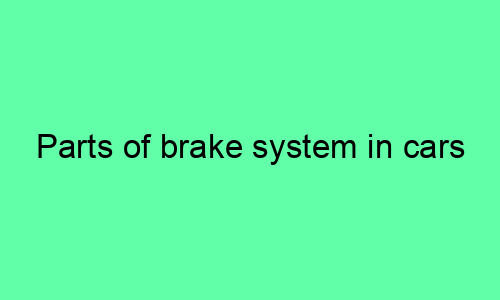Parts of Brake System in Cars
Master Cylinder
The master cylinder is the heart of the brake system. It converts the force applied to the brake pedal into hydraulic pressure. This pressure is then transmitted to the brake calipers and wheel cylinders, which in turn apply the brakes to the wheels.
Brake Lines
Brake lines are the tubes that carry the hydraulic fluid from the master cylinder to the brake calipers and wheel cylinders. They are typically made of steel or copper, and they must be strong enough to withstand the high pressure of the brake fluid.
Brake Calipers
Brake calipers are the components that apply the brakes to the wheels. They are mounted on the wheel hub, and they use pistons to force the brake pads against the brake rotors.
Brake Pads
Brake pads are the摩擦材料that are pressed against the brake rotors to slow down the wheels. They are made of a variety of materials,包括陶瓷、金属和有机化合物。
Brake Rotors
Brake rotors are the discs that the brake pads press against to slow down the wheels. They are typically made of cast iron, and they are designed to dissipate heat quickly.
Wheel Cylinders
Wheel cylinders are similar to brake calipers, but they are used on drum brakes instead of disc brakes. They use pistons to force the brake shoes against the brake drums.
Brake Shoes
Brake shoes are the friction material that are pressed against the brake drums to slow down the wheels. They are typically made of a combination of metal and organic materials.
Brake Drums
Brake drums are the rotating components that the brake shoes press against to slow down the wheels. They are typically made of cast iron, and they are designed to dissipate heat quickly.
Parking Brake
The parking brake is a secondary braking system that is used to keep the car from rolling when it is parked. It is typically operated by a lever or pedal, and it engages the brakes on the rear wheels.
Brake Fluid
Brake fluid is the hydraulic fluid that is used to transmit the force from the master cylinder to the brake calipers and wheel cylinders. It is typically made of a glycol-based fluid, and it must be able to withstand the high temperatures and pressures of the brake system.
ABS (Anti-Lock Braking System)
ABS is a safety feature that prevents the wheels from locking up during braking. It does this by monitoring the wheel speed and modulating the brake pressure to each wheel. This allows the driver to maintain control of the car even when braking hard.
Traction Control
Traction control is a safety feature that helps to prevent the wheels from spinning when accelerating. It does this by monitoring the wheel speed and applying the brakes to the wheels that are spinning too fast. This helps to maintain traction and prevent the car from losing control.
Electronic Stability Control
Electronic stability control (ESC) is a safety feature that helps to prevent the car from skidding. It does this by monitoring the car’s motion and applying the brakes to the wheels that are losing traction. This helps to keep the car on track and prevent it from spinning out of control.






